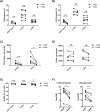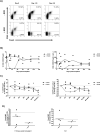Basiliximab impairs regulatory T cell (TREG) function and could affect the short-term graft acceptance in children with heart transplantation
- PMID: 33436905
- PMCID: PMC7803770
- DOI: 10.1038/s41598-020-80567-9
Basiliximab impairs regulatory T cell (TREG) function and could affect the short-term graft acceptance in children with heart transplantation
Abstract
CD25, the alpha chain of the IL-2 receptor, is expressed on activated effector T cells that mediate immune graft damage. Induction immunosuppression is commonly used in solid organ transplantation and can include antibodies blocking CD25. However, regulatory T cells (Tregs) also rely on CD25 for their proliferation, survival, and regulatory function. Therefore, CD25-blockade may compromise Treg protective role against rejection. We analysed in vitro the effect of basiliximab (BXM) on the viability, phenotype, proliferation and cytokine production of Treg cells. We also evaluated in vivo the effect of BXM on Treg in thymectomized heart transplant children receiving BXM in comparison to patients not receiving induction therapy. Our results show that BXM reduces Treg counts and function in vitro by affecting their proliferation, Foxp3 expression, and IL-10 secretion capacity. In pediatric heart-transplant patients, we observed decreased Treg counts and a diminished Treg/Teff ratio in BXM-treated patients up to 6-month after treatment, recovering baseline values at the end of the 12-month follow up period. These results reveal that the use of BXM could produce detrimental effects on Tregs, and support the evidence suggesting that BXM induction could impair the protective role of Tregs in the period of highest incidence of acute graft rejection.
Conflict of interest statement
The authors declare no competing interests.
Figures





Similar articles
-
Regulatory T cells in kidney transplant recipients: the effect of induction immunosuppression therapy.Nephrol Dial Transplant. 2012 Jun;27(6):2576-82. doi: 10.1093/ndt/gfr693. Epub 2011 Dec 13. Nephrol Dial Transplant. 2012. PMID: 22167587
-
CD4+CD25+CD127-Foxp3+ and CD8+CD28- Tregs in Renal Transplant Recipients: Phenotypic Patterns, Association With Immunosuppressive Drugs, and Interaction With Effector CD8+ T Cells and CD19+IL-10+ Bregs.Front Immunol. 2021 Jul 15;12:716559. doi: 10.3389/fimmu.2021.716559. eCollection 2021. Front Immunol. 2021. PMID: 34335631 Free PMC article.
-
The impact of induction therapy on the homeostasis and function of regulatory T cells in kidney transplant patients.Nephrol Dial Transplant. 2014 Aug;29(8):1587-97. doi: 10.1093/ndt/gfu079. Epub 2014 Apr 24. Nephrol Dial Transplant. 2014. PMID: 24771499
-
Advances on Non-CD4 + Foxp3+ T Regulatory Cells: CD8+, Type 1, and Double Negative T Regulatory Cells in Organ Transplantation.Transplantation. 2015 Aug;99(8):1553-9. doi: 10.1097/TP.0000000000000813. Transplantation. 2015. PMID: 26193065 Free PMC article. Review.
-
Prevention of allograft rejection by amplification of Foxp3(+)CD4(+)CD25(+) regulatory T cells.Transl Res. 2009 Feb;153(2):60-70. doi: 10.1016/j.trsl.2008.12.001. Epub 2008 Dec 25. Transl Res. 2009. PMID: 19138650 Free PMC article. Review.
Cited by
-
Alloreactive T cells temporarily increased in the peripheral blood of patients before liver allograft rejection.Liver Transpl. 2024 Dec 1;30(12):1250-1263. doi: 10.1097/LVT.0000000000000425. Epub 2024 Jun 21. Liver Transpl. 2024. PMID: 38900031 Free PMC article.
-
Transcriptomic analysis of graft liver provides insight into the immune response of rat liver transplantation.Front Immunol. 2022 Nov 3;13:947437. doi: 10.3389/fimmu.2022.947437. eCollection 2022. Front Immunol. 2022. PMID: 36426354 Free PMC article.
-
Immune Reconstitution of Patients Who Recovered From Steroid-Refractory Acute Graft-Versus-Host Disease After Basiliximab Treatment.Front Oncol. 2022 Jul 15;12:916442. doi: 10.3389/fonc.2022.916442. eCollection 2022. Front Oncol. 2022. PMID: 35936697 Free PMC article.
-
A Novel GMP Protocol to Produce High-Quality Treg Cells From the Pediatric Thymic Tissue to Be Employed as Cellular Therapy.Front Immunol. 2022 May 16;13:893576. doi: 10.3389/fimmu.2022.893576. eCollection 2022. Front Immunol. 2022. PMID: 35651624 Free PMC article.
-
The Presence of a Marked Imbalance Between Regulatory T Cells and Effector T Cells Reveals That Tolerance Mechanisms Could Be Compromised in Heart Transplant Children.Transplant Direct. 2021 Apr 23;7(5):e693. doi: 10.1097/TXD.0000000000001152. eCollection 2021 May. Transplant Direct. 2021. PMID: 33928185 Free PMC article.
References
-
- Kahan BD, Rajagopalan PR, Hall M. Reduction of the occurrence of acute cellular rejection among renal allograft recipients treated with basiliximab, a chimeric anti-interleukin-2-receptor monoclonal antibody. United States Simulect Renal Study Group. Transplantation. 1999;67:276–284. doi: 10.1097/00007890-199901270-00016. - DOI - PubMed
Publication types
MeSH terms
Substances
LinkOut - more resources
Full Text Sources
Other Literature Sources
Medical

